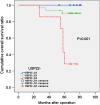Elevated expression of USP22 in correlation with poor prognosis in patients with invasive breast cancer
- PMID: 21691749
- PMCID: PMC11827975
- DOI: 10.1007/s00432-011-0998-9
Elevated expression of USP22 in correlation with poor prognosis in patients with invasive breast cancer
Abstract
Purpose: Ubiquitin-specific protease 22 (USP22), a novel deubiquitinating enzyme, has been associated with metastasis, therapy resistance, and cell-cycle progression. The purpose of this study was to investigate the expression level of USP22 in breast samples and to evaluate its clinical significance in breast cancer patients.
Methods: Immunohistochemistry was used to determine the expression of USP22 protein in 31 breast fibroadenoma and 100 breast cancer patients in comparison with 34 normal breast specimens. Furthermore, we analyzed the correlation between the expression of the USP22 protein and various clinicopathologic factors including survival status of patients with breast cancer.
Results: The immunohistochemistry results showed that the expression level of USP22 protein in breast cancer samples was significantly higher than that in breast fibroadenoma and normal breast tissues (P = 0.003 and P = 0.021). Moreover, statistical analysis showed that high USP22 expression was positively related to lymph node metastasis, Her-2, Ki67, and recurrence. Furthermore, it was shown that patients with high USP22 expression had significantly poorer outcome compared with patients with low expression of USP22 for patients with positive lymph nodes. Multivariate Cox regression analysis revealed that USP22 expression level was an independent prognostic factor for both overall survival and disease-free survival (P = 0.039 and P = 0.041, respectively).
Conclusion: Overexpression of USP22 may contribute to the progression of breast cancer and thus may serve as a new molecular marker to predict the prognosis of breast cancer patients.
Figures




Similar articles
-
USP22 nuclear expression is significantly associated with progression and unfavorable clinical outcome in human esophageal squamous cell carcinoma.J Cancer Res Clin Oncol. 2012 Aug;138(8):1291-7. doi: 10.1007/s00432-012-1191-5. Epub 2012 Mar 25. J Cancer Res Clin Oncol. 2012. PMID: 22447106 Free PMC article.
-
Overexpression of LAPTM4B: an independent prognostic marker in breast cancer.J Cancer Res Clin Oncol. 2013 Apr;139(4):661-7. doi: 10.1007/s00432-012-1368-y. Epub 2013 Jan 6. J Cancer Res Clin Oncol. 2013. PMID: 23292099 Free PMC article.
-
The prognostic significance of WWOX expression in patients with breast cancer and its association with the basal-like phenotype.J Cancer Res Clin Oncol. 2011 Feb;137(2):271-8. doi: 10.1007/s00432-010-0880-1. Epub 2010 Apr 18. J Cancer Res Clin Oncol. 2011. PMID: 20401669 Free PMC article.
-
Cost-effectiveness of using prognostic information to select women with breast cancer for adjuvant systemic therapy.Health Technol Assess. 2006 Sep;10(34):iii-iv, ix-xi, 1-204. doi: 10.3310/hta10340. Health Technol Assess. 2006. PMID: 16959170
-
Impact of residual disease as a prognostic factor for survival in women with advanced epithelial ovarian cancer after primary surgery.Cochrane Database Syst Rev. 2022 Sep 26;9(9):CD015048. doi: 10.1002/14651858.CD015048.pub2. Cochrane Database Syst Rev. 2022. PMID: 36161421 Free PMC article.
Cited by
-
Epigenetic Factors and Mitochondrial Biology in Yeast: A New Paradigm for the Study of Cancer Metabolism?Front Pharmacol. 2018 Nov 21;9:1349. doi: 10.3389/fphar.2018.01349. eCollection 2018. Front Pharmacol. 2018. PMID: 30524288 Free PMC article. Review.
-
USP22 Functions as an Oncogenic Driver in Prostate Cancer by Regulating Cell Proliferation and DNA Repair.Cancer Res. 2020 Feb 1;80(3):430-443. doi: 10.1158/0008-5472.CAN-19-1033. Epub 2019 Nov 18. Cancer Res. 2020. PMID: 31740444 Free PMC article.
-
USP22 positively modulates ERα action via its deubiquitinase activity in breast cancer.Cell Death Differ. 2020 Nov;27(11):3131-3145. doi: 10.1038/s41418-020-0568-2. Epub 2020 Jun 3. Cell Death Differ. 2020. PMID: 32494025 Free PMC article.
-
ShRNA-mediated silencing of the ubiquitin-specific protease 22 gene restrained cell progression and affected the Akt pathway in nasopharyngeal carcinoma.Cancer Biol Ther. 2015;16(1):88-96. doi: 10.4161/15384047.2014.987029. Cancer Biol Ther. 2015. PMID: 25482932 Free PMC article.
-
Epinephrine promotes breast cancer metastasis through a ubiquitin-specific peptidase 22-mediated lipolysis circuit.Sci Adv. 2024 Aug 16;10(33):eado1533. doi: 10.1126/sciadv.ado1533. Epub 2024 Aug 16. Sci Adv. 2024. PMID: 39151008 Free PMC article.
References
-
- Amerik AY, Hochstrasser M (2004) Mechanism and function of deubiquitinating enzymes. Biochim Biophys Acta 1695(1–3):189–207 - PubMed
-
- Berger SL (2007) The complex language of chromatin regulation during transcription. Nature 447(7143):407–412 - PubMed
-
- Bolden JE, Peart MJ, Johnstone RW (2006) Anticancer activities of histone deacetylase inhibitors. Nat Rev Drug Discov 5(9):769–784 - PubMed
-
- Choi HK, Choi BC, Lee SH, Kim JW, Cha KY, Baek KH (2003) Expression of angiogenesis- and apoptosis-related genes in chorionic villi derived from recurrent pregnancy loss patients. Mol Reprod Dev 66(1):24–31 - PubMed
MeSH terms
Substances
LinkOut - more resources
Full Text Sources
Other Literature Sources
Medical
Research Materials
Miscellaneous

